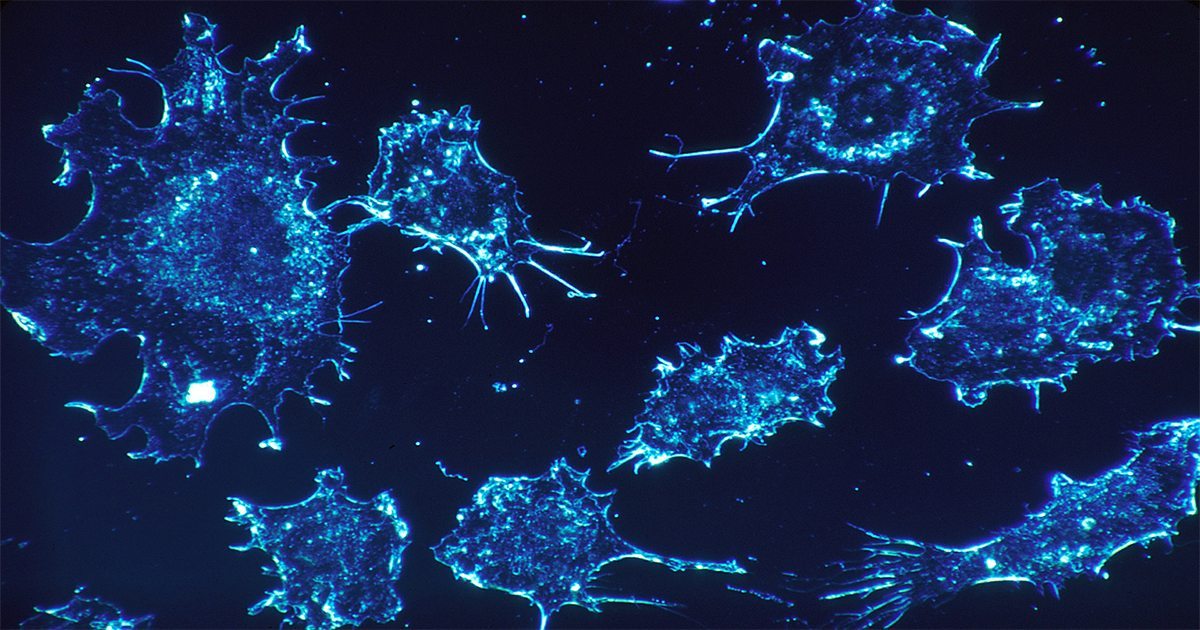Month: February 2017

A Pair of Proteins Could Lead to a New Lung Cancer or Mesothelioma Treatment
Last month, MesotheliomaHelp reported on early research from the UK where resea
rchers identified the Spns2 gene could reduce metastasis in lung cancer, and, potentially, in mesothelioma. Identifying a gene or protein effective in halting metastasis is a hot research topic, and now, another team of researchers report they have taken a closer look at a two-part protein to assess its ability to slow cancer growth.
Researchers from the Medical University of South Carolina (http://academicdepartments.musc.edu/newscenter/2016/wrangle-rubinstein-lung-cancer.html) knew that the NRP genes, NRP1 and NRP2, are up-regulated in cancer tumors leading to poor patient prognosis. However, the NRP2 protein is comprised of a 2a and 2b isoform, and when the scientists delved deeper into the effects on lung cancer, they found that while the two are “nearly identical” the differences were significant enough to affect cancer progression.
“Whenever we expressed NRP2b the cancer metastasized, and whenever we expressed NRP2a progression and metastasis were suppressed,” said Robert Gemmill, Ph.D. who holds the Melvyn Berlinsky Endowed Chair for Cancer Research at MUSC. “Clearly, with the 2b isoform, we have found something that promotes metastasis.”
Lung cancer and pleural mesothelioma, the signature cancer of asbestos, are both aggressive and both quickly metastasize, limiting survival. Past research has shown that it is this metastasis, not the original cancer tumors, that leads to death in nearly 90 percent of cancer patients. Unlocking the mystery of metastasis is critical for helping patients lead a longer life.
Through various experiments, the MUSC team found that the potent tumor suppressor, SEMA3F, was reduced or lost, while NRP2b was induced, leading to lung cancer progression. They then found that when NRP2b was knocked out, or suppressed, and NRP2a was induced, chemotherapy resistance was limited, and metastasis was limited.
These findings were encouraging to the team and they hope the findings will “open new avenues for potential therapies,” and that other scientists will pick up the research for development of new treatments for lung cancer. Gemmill points out that uncovering the effects of NRP2b could lead to monoclonal antibodies to target the 2b isoform, new immunotherapies, and possibly using NRP2b as a biomarker for predicting patients’ responses to treatment.
“I think a lot of people are going to sit up when they read this article and say, ‘I wonder what it does in my system?'” said Gemmill.
Nearly 3,000 Americans are diagnosed with mesothelioma each year. The cancer is terminal, and the prognosis is often less than 18 months.
Read the full study in the Jan. 17 issue of Science Signaling (http://stke.sciencemag.org/content/9/450/rs12).

Progress in Treatment Comes from Past Experiences
When patients and families are beginning their journey with mesothelioma, it is hard not to get discouraged when looking at survival statistics. The statistics are often interpreted as devastating, but, keep in mind that they are just that: statistics. Progress in the treatment of mesothelioma is being made slowly.
I have taken care of mesothelioma patients for years throughout their journey, whether that be in the intensive care unit, before their surgery, after their surgery, non-surgical patients and during all different phases of the disease. I can put faces and events to the different phases of the mesothelioma journey. And I still remember one patient from years ago who shows us how progress in mesothelioma care has been made, and how important it is to get to a mesothelioma treatment center.
Years ago, this man in his early 50s, who had worked in shipyards and was diagnosed with mesothelioma, traveled from out of state for specialized care for his mesothelioma. He had surgery, and was recovering well, but while still in the hospital he developed a blood clot that went to his lung, a pulmonary embolus. He became acutely short of breath and despite immediate medical intervention he died. It was a devastating complication, and he is still remembered by those who took care of him. Treatment has changed now, and it was by learning from the treatment of other mesothelioma patients that it has improved.
Now, in 2017, when any mesothelioma patient has surgery they are placed in pneumatic boots, that compress the legs to avoid blood clots. Patients routinely undergo non-invasive ultrasounds of their extremities to look for any blood clots on postoperative day seven. Walking is emphasized before and after surgery. If a patient has to stay in bed, they are placed on an anti-coagulant subcutaneous injection to help prevent any clots. Clots are screened for, and aggressively treated if detected.
This week, a mesothelioma specialist gave a talk and he referenced how important it is to come to a mesothelioma center. Although progress is being made, it is probably not fast enough for anybody. Yet, we have learned and progressed, and treatment is constantly being analyzed and perfected.

What the Mesothelioma Commercials Don’t Tell You
If you live in the U.S., you may have learned everything you know about mesothelioma through television advertisements by law firms with the meme “If You or a Loved One Has Been Diagnosed with Mesothelioma”. Although these commercials paint a bleak picture for victims of the disease and ensure the viewers that compensation is available to them, there is still plenty more viewers should know about mesothelioma.
Facts About Mesothelioma:
- Mesothelioma is a deadly cancer caused by past exposure to asbestos. There are few effective treatments, and there is no cure.
- Most often, asbestos exposure occurred at work. Victims often worked as plumbers, pipefitters, insulators, electricians, mechanics, car mechanics and in shipyards and mills.
- Military veterans make up nearly one-third of all mesothelioma cases. Military veterans were exposed to asbestos in the barracks, on ships and in boiler rooms, among other places.
- Spouses and children of workers who brought asbestos fibers home on their clothes, shoes and hair can develop mesothelioma. This form of exposure is known as second-hand exposure and is just as lethal.
- Mesothelioma symptoms, such as pain, coughing and difficulty with breathing, develop decades after the initial asbestos exposure. It can take as long as 60 years before symptoms present themselves.
- Nearly 3,000 Americans are diagnosed with mesothelioma each year with approximately the same number losing their lives to the disease.
Compensation for Mesothelioma Victims
A complex, aggressive, and incurable disease, like mesothelioma, requiring the services of specialized doctors, complex treatments, and caregiver support can lead to excessive bills. Managing these costs is challenging and sometimes even impossible. However, compensation for physical, emotional and psychological pain and suffering may be available to mesothelioma victims.
It is important to take action to claim compensation for your asbestos disease. The time you have to make a claim begins counting down the day you are diagnosed with mesothelioma. The time limit, or statute of limitations, varies by state. In New York, for example, you have three years to file a claim.
- Military veterans: Have a legal right to claim financial compensation from the asbestos manufacturers that resulted in the illness. Veteran’s may also be eligible to file a claim with the Veteran’s Administration for compensation.
- Workers: Establishing the source of workers’ asbestos exposure will determine which asbestos company is responsible for the illness and, ultimately, responsible for compensation.
- Second Hand Exposure: Late last year, the California Supreme Court ruled that companies whose employees bring asbestos fibers home with them can be held liable in the case of an illness in a family member. This helps ensure that these mesothelioma victims receive compensation just as those workers or veterans who were at the source of the asbestos are eligible.
Lawyers Can Help You Make Financial Claims
You should find a lawyer who is compassionate and knowledgeable and with whom you feel comfortable enough to get you the best compensation.
If you want to make a claim for VA benefits, understanding the process and working through all the red tape can be daunting. Securing a lawyer can give you the best results.
Your health should be your biggest concern, and Mesothelioma Help encourages those diagnosed with mesothelioma to first research all possible treatment options and seek out mesothelioma specialists for the best care.
To better understand the cancer and how to move forward, get free a Patient’s Guide to Mesothelioma from the New York Mesothelioma law firm of Belluck & Fox, LLP.
- Find out about your treatment options and typical prognosis.
- Use the handy reference for your medical and legal questions.
- Use the personal journal to track your treatments and other important information
Anyone who has been diagnosed with mesothelioma should understand that they are a victim. Mesothelioma does not just happen to you, it is caused by the negligence of companies. They should be held responsible for your illness and should compensate you for the illness they caused.

World Cancer Day Another Chance to Bring Attention to Mesothelioma
The National Cancer Institute reports 95% of the cancer diagnoses are dependent on choices we make every day, such as food selection, smoking decisions, sun exposure and exercise habits. Making poor choices can negatively impact our ability to age gracefully and to enjoy a full, productive life. Although Americans diagnosed with mesothelioma doubtful had control over the circumstances leading to their disease, raising awareness about all causes of cancer on Feb 4, World Cancer Day, may help prevent others from having to deal with the devastation that comes with a cancer diagnosis.
Nearly 8.2 million people across the globe die from cancer each year. Feb 4 is one day that is set aside every year to “spread the word and raise the profile of cancer in people’s minds and in the world’s media,” according to WorldCancerDay.org. With the goal to unite the world’s population in the fight against cancer, the organization hopes that by raising awareness and educating the public about the disease, countless lives will be saved.
“World Cancer Day is a chance to reflect on what everyone can do to reduce the impact of this devastating disease, now, and for the future. We wish it to be a springboard for positive change. Take action for yourself, your organisation or your community/country, as everyone can make a difference and inspire others. ‘We can. I can.’ beat cancer,” noted Professor Tezer Kutluk, President, Union for International Cancer Control (UICC).
For the mesothelioma community, this is another chance to shine a light on the pain and suffering over 3,000 Americans have to deal with each day as they are told they have mesothelioma. The rare, incurable disease, brought on by past asbestos exposure, can take decades for the cancer to develop, primarily impacting military veterans and trade workers.
The World Health Organization (WHO) estimates that 125 million people are annually exposed to asbestos in the workplace. The only sure way to stop the suffering and deaths caused by mesothelioma and asbestos-related disease is by preventing exposure, and WHO has been calling for a ban of asbestos use throughout the world. Once widely used in many applications, asbestos is now classified as a human carcinogen. Although the U.S. government regulates the use of asbestos today, it is still not banned in the U.S., as many mistakenly believe.
One of the primary objectives of World Cancer Day is to reach as much of the world’s population as possible during the day. The organization believes that any action anyone takes to educate others has an impact. Through the campaign theme, “We can. I can.”, everyone is encouraged to get involved in the fight against cancer.
“Join us on World Cancer Day to take action on cancer by making health and well-being commitments, participating in the official ‘Talking Hands’ social media activity and getting involved in hundreds of other awareness raising initiatives that are happening worldwide,” said Kutluk.

Patient and Caregiver Dealing With a Mesothelioma Recurrence
“Cancer that has recurred (come back), usually after a period of time during which the cancer could not be detected. Cancer may come back to the same place as the original (primary) tumor or to another place in the body. Also called recurrent cancer,” is the National Cancer Institute’s definition of recurrence.
Over the years, I have cared for many patients who have not only had to deal with the initial diagnosis of mesothelioma, but also with subsequent recurrences. Sometimes, like the patient I saw this week, recurrence is mentally challenging to the patient and the family. The patient, a man in his early 70s, had his disease return to the other lung, the non-operative side. He is physically weak and having trouble breathing. Mentally, though, he is alert but full of despair. His caregiver is angry and frustrated. It is hard not to be filled with these emotions after they have tried so hard to fight this disease with the best tools that are available, but still it has progressed and returned.
The caregiver was angry at the doctor, hospital, the rest of the family, anybody she came into contact with. Dealing with her anger, and his despair, can be very challenging. The focus needs to shift by turning the emotions into fighting the disease not each other. Fight the symptoms, the pain, the shortness of breath-make those the enemy.
While dealing with all of the emotion, the medical team must focus on the patient‘s desires. When asked what he wanted to do, the man said he wants to be home for his last days. Even while his team looks for ways to make this a reality, his caregiver cannot see her way for it to happen. It will take time and continuous support for both the patient and the caregiver to work through everything.
How do people cope with their emotions when mesothelioma returns? We have seen a variety of responses all unique to each patient. Visit the National Cancer Society web site for some very helpful advice and resources for the caregiver and patient.
Everyone’s mesothelioma and situation is different, and a recurrence, for some is just a setback that can be overcome both physically and emotionally. Many patients have progressed to where mesothelioma is treated as a chronic, ongoing disease.
The faces of recurrence are as varied as each individual’s journey with this aggressive disease. During these times it is the most difficult to remain positive. Reach out, there are resources and people to help you and your family get through the dark days.
Free Mesothelioma Patient & Treatment Guide
We’d like to offer you our in-depth guide, “A Patient’s Guide to Mesothelioma,” absolutely free of charge.
It contains a wealth of information and resources to help you better understand the condition, choose (and afford) appropriate treatment, and exercise your legal right to compensation.
Download Now